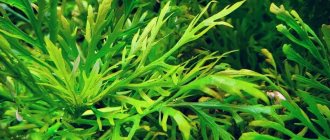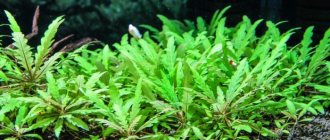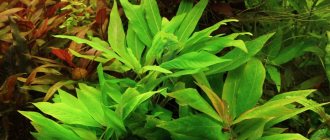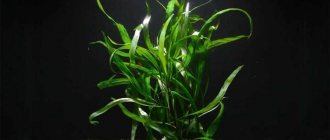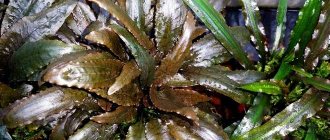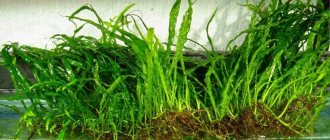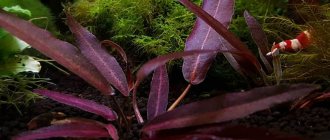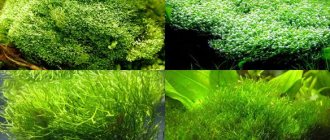The leaf blades of Hygrophila corymbosa grow up to 12 cm in length and up to 6 cm in width. Its green bush grows up to 15 cm wide and requires a lot of space in the aquarium. Under good conditions, it can emerge above the surface of the water in small aquariums, which is why the leaves of Hygrophila corymbosa acquire a dark green tint.
Keeping hygrophila in the aquarium
Hygrophila is a beautiful and useful plant in an aquarium: it absorbs nitrates, purifies water, and serves as a substrate for fish spawning. Hygrophila is polymorphic: the process of changing appearance and flowering is observed when the bush reaches the surface. The plant develops as a land plant in moist air under a cover glass. Getting from the paludarium into the aquarium, hygrophila is reconstructed and becomes a typical aquatic plant. Hygrophila
is an unpretentious plant that remains viable in the temperature range of 18-30°C. Grows in low light and without soil. Hygrophila shows the best results in bright light and the presence of humus-rich soil. Depending on the height of the bush, greens are planted in the foreground or along the back wall of the aquarium.
Benefits for the aquarium
Dwarf lemongrass is useful for the aquarium. Thanks to the plant, you can get rid of unnecessary algae. Hygrophila is capable of consuming most of the phosphates and nitrates. Its role is invaluable in establishing biological balance in the aquarium. In addition, lemongrass is able to establish nitrogen metabolism in the environment in which it is located. The plant is a phosphate indicator.
Hygrophila polyspermous or Indian or Swamp: maintenance and breeding
Photo: Hygrophila polysperma
Photo: Hygrophila polysperma
Photo: Hygrophila polysperma
Photo: Hygrophila polysperma
Homeland - Southeast Asia. This plant is also called "Indian star". A long-stemmed plant with oval light green leaves, very popular among aquarists. Its stems can reach considerable length. Hygrophila can be grown in an aquarium of any size, placing it in the background. In the aquarium it grows evenly throughout the year. It is better to keep the plant in a tropical aquarium at a temperature of 24-28 °C. At water temperatures below 22 °C it grows poorly. The water is soft, slightly acidic. When the hardness is more than 8°, growth deteriorates, the lower leaves fall apart, and the upper ones become small. Regular water changes are necessary. The lighting should be bright, as indicated by the light green color of the leaves. To illuminate the aquarium, you can use both natural and artificial light. If sunlight falls directly on the aquarium, the hygrophila should be shaded. For artificial lighting, fluorescent lamps of the LB type are better suited, but incandescent lamps can also be used; When calculating the power of lighting fixtures, you need to proceed from the following proportion: 0.4-0.5 W per 1 liter of volume for fluorescent lamps. The power of incandescent lamps should be approximately three times greater. Daylight hours are at least 12 hours. With insufficient lighting, the leaves become much smaller, and the stem begins to stretch greatly. For growing Hygrophila polysperma, lightly silted soil consisting of coarse sand or very small pebbles is suitable. Additional fertilizing is not required; the plant is fully satisfied with natural siltation of the soil. If there are a lot of plants in the aquarium and they grow quickly, they need to be fed with complex mineral fertilizers. With a weekly water change of 10 liters, 1.5-2 g of fertilizer is added. Hygrophila is very easily propagated by stem cuttings. In this case, parts of the stem that have 4-5 whorls of leaves must be immediately planted in the ground, deepening the lower pair of leaves. The root system forms very quickly. It is impossible to grow hygrophila floating in the water column, since its root system takes an active part in the absorption of nutrients and develops very poorly outside the ground. The leaves of a floating plant become smaller and its growth slows down. Like other hygrophila species, polyspermous hygrophila is a marsh plant and can be successfully grown in a paludarium and in a wet greenhouse. Growing in an air environment is not difficult: in a humid atmosphere on sufficiently nutritious soil with bright light, the plant develops very quickly.
Spreading
The main habitat is the reservoirs of Southeast Asia. The plant is often found in marshy areas, making it well suited to paludariums or wet greenhouses.
Common varieties
The most common. The cross-shaped arrangement of leaves forms a geometrically correct pattern. A tropical aquarium with a water temperature of 24 °C and bright lighting is the most comfortable for growth and development. Hard water is a prerequisite for keeping Schisandra; in soft water, the plant loses its lower leaves and, as a result, its decorative qualities.
Not as demanding of light as other species. The top does not shade the lower parts of the plant. Leaving the underwater space, Schisandra loses its decorative properties. The leaf becomes short and stiff, the stem becomes pubescent. It is recommended to trim it regularly and root the apical parts. The process of reproduction in the aquatic environment is elementary, similar to the previous type.
Serrated Nomaphyla
It is distinguished by its dark leaf color and modest decorative properties, especially in its above-water form. It is recommended to trim the tops; with this treatment, Schisandra begins to form bushes. In soft water, the plant loses its leaves and does not regenerate them. The ability to propagate by cuttings allows you to quickly replace dead individuals.
Serious competitors of ordinary lemongrass are Nomafila serrata and Nomaphila thailandica. They are often the choice of discerning aquarists:
- Toothed algae has leaves with a sparser arrangement, on the edges of which there are pointed formations. Because of this feature, the plant does not require a lot of bright light. The leaves of Schisandra angustifolia, located in the upper part, do not create a strong shadow, so the lower branches receive enough light.
- The Thai variety always looks elegant in an aquarium. It is distinguished by small leaves that densely cover the stem. The general shape of this algae is very similar to a branched and lush shrub.
Difficulties of care
Keeping lemongrass in an aquarium, provided favorable conditions are provided for it, does not cause any trouble. Intensive growth of shoots is noted, and the green mass grows so quickly that in the absence of regular mowing, it will occupy all the free space of the artificial reservoir. It is more convenient to control the growth process if the algae is planted not in the aquarium soil, but in a special clay pot. It will prevent rapid development of the root system while ensuring moderate growth of the green part.
Important! Choosing a pot that is too large for planting is the wrong decision. The development of the above-ground part will stop completely, since all activity will focus on growing the rhizome.
With proper, consistent pruning of the plant, it can be given the desired shape. The side shoots will stretch to the sides, creating a lush and attractive bush.
Appearance
Dwarf lemongrass appeared thanks to selection in the Netherlands. It differs from ordinary hygrophila in its small size. The plant most often grows in height from 10 to 15 cm. The strongly flattened stem of hygrophila begins to branch right at the root, and many leaves are formed, with a small distance between them. Dwarf lemongrass is capable of forming a large number of lateral shoots. The leaf blades of the plant are light green, silvery on the reverse side. After pinching the top stops the growth of the main stem, the lemongrass begins to branch quite quickly, resulting in dense bushes. In this form, the plant is often compared to Japanese bonsai. Dwarf lemongrass is valued for its high decorative properties. These are compact bushes with a lot of leaves. It can look great against the background of other aquarium plants. Hygrophila corymbosa compacta grows at an average speed. This property distinguishes it from other Hygrofils, which have a high growth rate and require more time to care for them.
How does a plant reproduce?
Dwarf lemongrass reproduces quite easily. To do this, you need to cut off the top with 3-4 internodes. In this case, after some time, new shoots will appear on the main trunk. A new place is selected for the cutting; after some time, the plant will take root and begin to grow. In this case, a powerful root system is formed. For normal growth, hygrophile requires fine soil, poured at least 3-5 cm. The plant feels comfortable at a water temperature of 20-28°C. Can withstand higher temperatures of 30°C.
How to plant?
Even if you chose the best specimen for your aquarium, but planted it inappropriately, the plant will not take root and will soon die. That is why it is necessary to take a responsible approach not only to the process of choosing aquarium greens, but also to planting them.
In order to plant lemongrass correctly, you must comply with some requirements in relation to aquarium soil:
- the thickness of the soil layer should be between 5 and 7 centimeters;
- Any soil base is suitable, since this plant has very strong roots and can take root in any soil;
- when replanting, you need to place a small layer of clay under the lemongrass root;
- There must be a concentration of nutrients and silt in the soil.
If the soil is favorable for the plant, then this is a recipe for complete success. However, do not forget about other factors that can contribute to the rapid growth of your lemongrass
Other features that you should pay attention to when planting include the following factors:
Editor's note: Glossolepis red
- Schisandra is sensitive to changes in the environment, so after planting you should not use copious amounts of fertilizer;
- abundant light will help the plant take root faster and promote rapid leaf growth;
- Schisandra is difficult to tolerate large amounts of sodium ions in water.
How to choose?
In order to create a beautiful and comfortable aquarium for your fish, some part of its perimeter should be occupied by algae. They will help create a beautiful look. Unlike artificial vegetation, live aquarium plants will provide benefits to your pets.
The choice of aquarium algae should be approached with due care. And lemongrass is no exception. To begin with, it is worth noting that algae for an aquarium can be divided into 3 categories according to their location: in the back, in the middle and in front of the aquarium.
Schisandra can usually be found either in the middle part or in the background of the aquarium (depending on the species).
To choose a good “seedling” for your aquarium, you should pay attention to several external signs. These include several factors.
- The stem should be a darker color compared to the foliage. And also it should not be too thin.
- The leaves should look healthy, without any plaque or blotches. Their color is usually slightly lighter than the stem. Depending on the plant variety, the back of the leaves may be a different color from the front, but this may not always be a bad sign.
- The roots must be at least 2-3 centimeters so that the plant can take root well in the soil of the aquarium. Make sure that the roots are without any damage.
What are the benefits of lemongrass?
Thai lemongrass is used in aquariums for its decorative properties. After all, the plant is distinguished by its density and elegance.
Algae is planted in a tank for another reason. They act as a filter that eliminates organic matter and the remains of the vital activity of individuals. They saturate the container with oxygen and remove remaining carbon dioxide.
Life cycle
Experienced aquarists note that with proper care, life expectancy can be measured in decades. This is due to the continuous cycle of reproduction.
Algae growth is the same throughout the year. After all, lemongrass “does not hibernate.”
Compatibility with the “residents” of the aquarium
Experienced aquarists do not plant lemongrass in tanks with ancistrus and cleaners. After all, these fish actively absorb the foliage of these plants.
Nomaphyla is planted in containers with other algae and shady plants. You should not plant them with those species that require shortened daylight hours. After all, this provokes a deterioration in appearance.
Schisandra is characterized by active growth. Therefore, it spreads throughout the tank, and other plants begin to rot and stop growing. The solution is simple - growth control, periodic pruning of “adult” plants, transplanting into other tanks and containers.
Algae should not be planted in close proximity to other plant varieties, decorative elements and driftwood.
Algae are not planted in tanks in which pistia grows. After all, pistia prevents their growth.
Diseases and treatment
Spots and other damage to algae appear due to the fact that the balance of key parameters is disrupted.
Problems and solutions
- The temperature of the aquarium water decreases. This provokes stunting of growth and deterioration of the leaves. Sometimes spots appear.
- Lack of light. When using a low-power lamp, the vegetation becomes less lush. Therefore, before installing a lighting device, experienced aquarists carry out calculations. This allows you to set the optimal power of the fluorescent lamp.
- Lack of rigidity. Specks are formed at reduced rigidity parameters. If the required balance of hardness is not restored, then the lemongrass is completely destroyed.
- Lack of substrate. Spots do not form with a thin layer of soil. The development of algae stops.
Spots are not the only sign of the disease. The absence of flowers also indicates non-compliance with the rules of care.
When diseased, the dark stem becomes lighter and becomes covered with microcracks. Therefore, periodic inspection is an important step in caring for this plant.
To create a harmonious environment in the aquarium, a responsible approach to the choice of vegetation is required. And lemongrass is the best option for small and large containers with fish. After all, it is compatible with many phenotypes and representatives of the fauna. Its planting is carried out without complex preparatory processes.
Hygrophila corymbosa, Schisandra, Hygrophila corymbosa
Family: Acanthaceae (Acanthaceae). Synonyms: Nomaphila corymbosa Blume (1826), Justica stricta Vahl, Nomaphila stricta (Vahl) Nees, Hygrophila stricta (Vahl) Lindau, etc. Trade name: H. “lacustris”, H. “siamensis”, H. “longifolius” and etc. Etymology: Hygrophila: hygros - wet, philein - to love, by habitat, corymbosa corymbosa, by inflorescence. Distribution: Widely distributed in Southeast Asia.
Description: marsh plant with an erect, branched stem up to 5 mm thick. The plant is naked (except for one form). The leaf arrangement is cruciform-opposite. Petiole 1-5 cm. Many genetically fixed, sterile plant forms are cultivated, the leaf blades of which vary greatly in shape and size.
Broad-leaved form: the leaf blade is narrow-ovate or elliptical, emergent, 6-8 cm long, 2.5-3.0 cm wide; underwater 10-20 cm long, 3-7 cm wide. There are pure olive-green or red-brown colored forms.
Thailand form: emergent leaf blade narrowly elliptical, 7-10 cm long, 1.5-2.5 cm wide, submerged leaf blade narrowly lanceolate, 10-20 cm long, 1.5-2.0 cm wide; one colored form with light green and the other with red-brown leaves. Pubescent form: an emergent plant (including the underside of the leaves), densely pubescent (almost bare at high air humidity), strongly aromatic. The emergent leaf blade is narrowly elliptical, 4–7 cm long, 1–1.5 cm wide; the underwater plate is linear, 1–30 cm long, 0.5–1.5 cm wide, light green.
The inflorescence is a dichasia with three to several flowers and a peduncle 0.5-2 cm long. Bract petals are 2-2.5 mm long and 0.5 mm wide. Individual flowers range from light blue to deep blue-violet. It has 5 sepals, hairy, 4-8 mm long, one of them is 1-3 mm longer than the others. The flower in the lower part grows together into a tube; corolla bilabial, 10-15 mm long. The upper lip is bifid; the lower lip is 3-parted, wrinkled-convex and with a white-blue pattern. It has 4 stamens, two of which reach almost the edge of the upper lip, while the remaining 2 are shorter. The pistil is up to 1.3 cm long. The carpels are cylindrical, 3.5 x 1.5 cm long. The capsule is 1-1.3 cm long, with 20 flat, almost round seeds.
Culture: all plant forms are fast growing and are recommended for keeping. Although in general their need for lighting is very moderate, the shoots become much more powerful and larger with more intense lighting. Red colored shapes look most beautiful in a free, bright place. Pebbles or washed sand are sufficient as soil, however, the shoots become larger and more powerful on nutritious soil or when appropriate fertilizers are added. H. corymbosa grows well in slightly alkaline water from medium to hard, with an optimal temperature range of 24-28 C. Surprisingly good growth rates are observed in water with a strong current, for example, near the filter outlet. This plant makes its greatest impression in a small group in the center or background of the aquarium. Over time, under good conditions, side shoots form, giving the group of plants a bushy appearance. These side shoots, 10 cm in size, can be separated and further used as cuttings.
Hygrophila corymbosa is usually sold as a terrestrial crop and in most cases loses its emergent leaves when planted in an aquarium; however, the plants continue to develop well in water and soon produce new leaves.
Ecology: the plant inhabits marshy biotopes. Two very different habitats have been observed on Sulawesi. Near Bantimurung, in a small river with a fast current, a narrow-leaved form with a small number of flowers grew both underwater and above water. Water analysis: temperature 28 °C; pH 7.5; GH 7.8 dH; KH 6 dH; 300 j.S/cm. In another habitat near Angkona, a fully terrestrial, broad-leaved, multi-flowered form grew only in moist soil.
Why is Schisandra called hygrophila and nomaphila?
Usually, when it comes to the classification of Schisandra, the primacy in the description is given to Karl Ludwig von Blum.
This is the same scientist who, while studying the flora of South Asia in 1826, described the plant as Nomaphila corimbosa. A little later, in 1895, another botanist (Gustav Lindau) again described the plant. And he gave it the systematic name Hygrophila corimbosa. However, Lindau took advantage of earlier works than Blum. The fact is that the genus Hygrophila was originally described in 1810 by Robert Brown. Since the plant was found to belong to the genus Hygrophila, Schisandra received the official name Hygrophila corimbosa. By the way.
For some time, lemongrass was classified in the genus Justicia. Much earlier, before the plant was named hygrophila and nomaphyla, Martin Wahl, a student of the famous Carl Linnaeus, had the opportunity to meet this herb in nature and give it a name, assigning it to the genus Justicia.
It is a little unclear what guided the botanist in his work. But time put everything in its place and the plant took its present position. However, confusion in names often confuses aquarists.
Thus, there is no reason to start a debate about the correct name of the aquarium plant.
In addition to the “main” names, lemongrass has a number of synonyms. These are Nomaphila angustifolia, salicifolia, siamensis and stricta.
Habitat indicator
Hygrophila compact is a good environmental indicator. By appearance you can understand which microelements it lacks.
If there is not enough potassium, then the external signs of the plant will appear as follows:
- Small holes will begin to appear on the leaves, most often the lower ones;
- New leaves will begin to grow smaller in size;
- The leaves begin to curl, become deformed, the lower ones and completely fall off;
- Leaf blades turn yellow;
- Slowly growing;
- The tops are dying off.
With a lack of phosphorus, the following occurs:
New growing leaves become dark green with a reddish tint.
2011-2020 “Aquarium in your home” - online magazine for aquarium lovers. When copying materials reference to the source is required!
Other types of hygrophila
Hygrophila reddish is a rather rare species. It is a tall plant with narrow red-brown leaves 6-8 cm long. It needs intense lighting, otherwise the leaves lose their original color, the stem stretches, and the lower leaves are destroyed. The plant also reacts poorly to soft acidic water - it turns pale, old leaves die.
Hygrophila polyspermous. This is a common plant and is sometimes called "Indian starfish". It has a long stem with light green oval leaves. Hygrophila prefers slightly silted soil; it usually does not need additional feeding. But if the bushes grow strongly, then they require mineral supplements. Hygrophila polysperma grows well in a paludarium or tropical greenhouse. It requires bright light, high humidity and nutritious soil.
Hygrophila varifolia, or Sinima. This is a beautiful plant, very popular among aquarists. It has a long stem with leaves whose shape depends on the light. In moderate light they are small oval, but if the light is bright, the leaves grow and take on a beautiful carved shape. This species is unpretentious. It can grow both in warm water and in water of moderate temperature +20°...+22°C, although its growth slows down somewhat. The hardness and reaction of water are unimportant for it.
Hygrophila Sinima is usually placed in the center of the aquarium. It requires nutritious soil made from coarse sand or small pebbles, but it also grows well in soil made from coarse fractions. This species can also be grown in deep water without soil. It propagates not only by cuttings and dividing the bush, but also by old leaves. To do this, the sheet is placed on a plate with sand, filled with water and placed in bright light.
According to the conditions of detention, all types of hygrophila differ little from each other: they need bright light and warm water of medium hardness with a neutral or slightly alkaline reaction. The water must be fresh and changed regularly. Plants prefer nutritious soil and periodic mineral fertilizing.
Editorial: Echinodorus Ocelot
Variations and forms of the plant
In addition to lemongrass, there are many species of hygrophila grown in aquariums. Let's look at a few popular representatives:
- Willow leaf. Like lemongrass, it grows in Southeast Asia in swampy areas and ponds. It grows on average 30-40 cm in height, has long narrow leaves up to 12 cm in length. The edges of the leaf plates are smooth or have a slightly jagged shape.
- Multi-seeded. The light green oval leaves of this hygrophila are located on a long, strong stem. Leaf blades can have a round or slightly pointed shape. The leaves usually have pinkish veins.
- Pinnatifida. Grows up to 15-30 cm in height. Depending on the lighting, the plant can have a color from red-burgundy to bright green. It can grow on stones and snags and has a weak root system.
- Aguay. Grows in Japan, Hong Kong and Brazil. The plant grows up to 15 cm in height. In submerged form it has narrow leaves of a red-brown color with a longitudinal silver stripe.
- Thyroid compact. In appearance it is similar to lemongrass, but has smaller dimensions, which is reflected in the name of the species. This hygrophila has a bushy appearance due to the large number of lateral shoots. It grows very slowly.
Diseases
With proper care, nomaphila blooms and pleases the eye, and there are no spots or growths on the leaves and stems. If conditions are violated, the plant becomes ill, as evidenced by the following signs:
- loss of integrity of leaves and small spots on them - the reason lies in too soft water;
- large dark spots – low water temperature; poor development and fragility - small thickness of the substrate;
- light or pale yellow spots – magnesium deficiency;
- leaves turn yellow and change shape, curling - lack of potassium;
- dying leaves - lack of lighting or too soft water;
- discoloration and purple spots on the leaves are a lack of nutrients.
To prevent the plant from getting sick, aquarists additionally feed the flower by adding mineral fertilizers to the water. Without these nutrients, lemongrass loses its beauty and develops poorly. The main signs that nomaphile does not have enough attention and care are spots on the stem and leaves, as well as the absence of blue flowers.
Description of the genus “Hygrophila”
Department Flowering, or Angiosperms (MAGNOLIOPHYTA), or (ANGIOSPERMAE) Family: Acanthaceae (Acanthaceae)
Grows in swamps and underwater in warm climates. The stem is elongated, erect, less often creeping. Leaf arrangement is opposite. The venation is pinnate. Flowers in the axils of emergent leaves. Planted in groups in nutritious soil.
Lighting: 0.4-0.5 W/l.
Water: 24-28°C, KH 2-15°, pH 6.5-7.5.
Propagated by cuttings. On a leaf or part of it floating on the surface of the water, a daughter plant is formed from an adventitious bud, which, after the formation of roots and leaves, is separated and planted in the ground. This method of reproduction is ineffective.
Other species of the genus:
- Hygrophila or Synnema triflorum (Hygrophila difformis or Synnema triflorum)
- Hygrophila spec. longifolia
- Reddish hygrophila (Hygrophila spec. “Reddish”)
Conditions for keeping lemongrass in an aquarium
Despite the great diversity, all forms of lemongrass growing in our aquariums have almost the same requirements for keeping conditions.
Comfortable conditions for water composition will be:
- Temperature 25 - 28°C. A decrease to 22 degrees leads not only to slower growth. The leaf is shed, the plant withers and dies.
- The total water hardness is at least 8.
- pH can fluctuate between 6.5 - 8.
The plant can grow in somewhat dim light. However, lush bush forms cannot be achieved. With a lack of lighting, the leaf blades turn pale and die. Therefore, the best option would be to combine overhead lighting with side lighting. In this case, the lower leaf is preserved for a long time, and the length of the internodes is also noticeably reduced. The length of daylight for a plant is at least 12 hours. In principle, this is optimal for all aquarium plants.
Weekly water changes are required. At least 1/5 of the total volume.
The soil must be rich in nutrients. Schisandra loves to “eat.” Excellent results are shown by growing lemongrass in pots. In any case, to obtain a beautiful plant you will need a soil height of at least 6-7 cm with the addition of clay under the roots. Light siltation under the bush can be left, if, of course, it does not bother you.
Schisandra propagates in an aquarium in the simplest way - by cuttings. A shoot of 10 - 15 centimes is cut off from the mother plant. It can be left to float in the water until roots appear. However, it is better to immediately plant it in the ground, deepening the lowest internode. With this planting, the young plant always has an even stem.
Schisandra cannot be called a completely aquatic plant. This is a typical amphibian, always striving to get to the surface of the water.
And that's okay. In addition to vegetative reproduction, nature forces sexual reproduction. Under normal conditions, nomaphyla blooms. However, there is one variety of lemongrass, which not only grows slowly in relation to its other brothers, but is also lazy to leave the water. This, oddly enough, is the Thai nomaphila.
Author Viktor Shestakov, experienced aquarist
Growing and caring for an aquarium - 4 rules
Hygrophila corymbosa is recommended to be kept in an aquarium with a tropical climate.
The vessel in which the lemongrass will be planted must have a volume of 150 liters or more, since it is recommended to place a group of hygrophiles at once. Bushes must be planted at a distance of 5-10 cm from each other. Otherwise, the roots may become intertwined.
The optimal distance between plants should be 5-10 cm
This aquarium plant requires regular thinning to prevent it from shading the bottom too much.
If you do not trim the tops of the shoots, Hygrophila corymbosa grows above the surface of the water and blooms with blue flowers.
Rule 1. Suitable water parameters
The water in the aquarium with corymbosa should be fresh. Acidity must be maintained at 6.5–7.5 pH. Hardness – no less than 8 dGH. Every week it is necessary to change 20-25% of the water.
The optimal temperature for dwarf magnolia vine is 24–2 8°C. It tolerates warmer water well. But if the temperature is below the specified norm, the corymbosa stops growing, and the leaves decrease in size.
A suitable nitrate concentration would be 5 mg/L. Schisandra distinguishes well the chemical elements present in the aquarium.
Hygrophila corymbosa prefers temperatures +24…+28 °C
Do not dissolve table salt or baking soda in aquarium water. This has a detrimental effect on the plant.
Corymbosa is absolutely unpretentious to forced filtration of water in the aquarium. In such a reservoir, low and medium power filters can be used. They should be installed in such a position that the stream is directed towards the aquarium plant.
Rule 2: Fine-tuning lighting
The lighting intensity in an aquarium with hygrophila corymboza “Compact” should be at least 50 lm/l. For this purpose, fluorescent lamps of medium and low power are used. If the plant begins to shed its lower leaves or they become brittle and holes form on them, it means that the corymbose does not have enough light. This can lead to the death of the aquarium plant.
Medium and low power fluorescent lamps are suitable for lighting an aquarium with a plant.
If the light illumination is arranged correctly, the corymbosa will have healthy, juicy green leaves and a bright brown stem.
Lighting in any aquarium is adjusted, focusing specifically on this flower.
Daylight hours for corymbosa should be 12 hours.
Daylight is optimal for corymbose growth. It should be remembered that direct sunlight has a detrimental effect on the delicate leaf blades of lemongrass and can burn them.
Due to too bright lighting, harmful algae such as “blackbeard” in the aquarium begin to grow and develop rapidly. They are located on all parts of the aquarium plant, take all the light, and the lemongrass dies.
You can also arrange side lighting. It will allow the leaves of the lower tier to maintain a bright, healthy color longer.
Side lighting will accelerate the growth and development of the plant
Rule 3. Soil with clay
Hygrophila corymbosa develops a fairly powerful root system. It would be correct to plant it in a substrate 5-7 cm thick. For this, you need nutritious soil with clay, which serves as a source of iron for aquarium plants.
It is recommended to plant an aquarium plant in nutrient soil with clay.
If corymboza is planted in washed pebbles or sand, then clay must be placed under the roots or special root tablets must be used. In clean soil, lemongrass will grow for a very long time. When the soil is sufficiently silted, additional fertilizing may not be necessary. Under optimal conditions, corymbosa can grow 10 cm in 1 week.
Aquarists, who often face the problem of landscaping an aquarium, recommend growing this particular aquarium plant as the most economical way to solve the existing problem.
Rule 4. Use of fertilizers
For better growth and development, maintaining the healthy appearance of Korymbose “Compact”, you can use mixtures specially developed for these purposes. Their composition is correctly balanced, they contain potassium, iron and other trace elements. It is necessary to use the mixtures strictly following the instructions attached to them.
Also, strictly according to the instructions, you can additionally add CO2 to the aquarium water.
For better growth and development of lemongrass, it is recommended to use special fertilizers
Nutrients enter the plant mainly through the root system. That is why it is optimal to use fertilizers in the form of tablets, which are placed under the roots.
Willow, or lake
This is one of the most common types of aquarium grass. Under natural conditions, Hygrophila loosestrife is found in ponds and swamps in Southeast Asia. This is a large plant, reaching a height of 30-40 cm. It is better to plant it on the sides or in the back of the aquarium so that it does not block the view.
From the editor: The smallest aquariumThe plant has a straight, smooth stem up to 1 cm thick and bright green leaves, lighter below. Their edges are smooth or with small teeth. They reach a length of 15 cm and a width of 0.8 cm. The leaf blades are straight or slightly curved. If the lighting in the aquarium is too strong, they turn brown.
In the above-water part of the plant, groups of white flowers are formed. Hygrophila grows well in an aquarium throughout the year and produces 2-4 new leaves per month. It can grow both in the water column and on the surface. Optimal conditions for keeping hygrophila loosestrife:
- water temperature from +24° to +28°C;
- hardness - up to 8° dH;
- acidity - from 6 to 8 pH;
- soil - nutritious, preferably coarse sand with silt;
- lighting is moderate, lasting 10-12 hours a day, with an intensity of 0.4-0.5 W/1l.
Water needs to be filtered and changed once a week by 20-25%. If its temperature is too low, the growth of the bushes will slow down. In hard water, the leaves and stem of the plant become brittle. When there is insufficient lighting, the plant’s stem stretches, the leaves turn pale and smaller, and it loses its attractiveness.
If the lighting is too bright, brown veins will appear on the leaves, and the above-water part will also develop greatly. The plant responds well to the application of mineral fertilizers. It grows intensively, its leaves become bright green.
The plant is easily propagated by cuttings. For cuttings, use a strong, healthy stem, cutting it into pieces with 5-6 whorls of leaves. The length of the cuttings should be at least 8-10 cm. They are planted in groups of three or four in the back or side of the aquarium.
It is best to combine hygrophila with small fish that will spawn on its leaves. The plant gets along well with fish that like to burrow into the ground. It has a powerful root system that is difficult to damage.
Compatibility
It is recommended to stock small species of fish, such as guppies, swordtails and other similar species, in an aquarium with hygrophila. They will be able to hide in the dense bushes of the aquarium plant, and also spawn on its leaves during the spawning period.
Swordtails
Guppy
Due to the well-developed root system, Corymbosa “Compact” will be an excellent neighbor to catfish and other pets that actively dig the ground.
You should not plant Corymbosa in the same aquarium with the following neighbors:
- fish that need dim lighting;
- the aquatic plant Pistia, which prevents Corymbosa from growing freely;
- with large snails like Achatina and Neretina, which eat the soft leaves of the plant.
Corimbose goes well with aquatic plants such as:
| |
| |
| |
|
They require similar care. And the beautiful green leaves of the plant look impressive in contrast with the dark round leaves, for example, of anubias.
Content Rules
Schisandra is a rather attractive and at the same time not very difficult to care for plant that can grow in an aquarium at your home. This type of plant is intended for growing in large aquariums (from 150 liters). In order for your plant to maintain its original attractive appearance, it is necessary to properly care for it.
And there are also a number of conditions that will help your “green pet” feel comfortable in its habitat.
The soil. It is imperative to have a clay-peat layer at least 5 centimeters wide. Schisandra will feel comfortable in a muddy substrate with fertilizers that include phosphorus, calcium, and magnesium.
Morphology, feeding and reproduction features
Hygrophila has a clear division into stem, leaves and roots. Depending on the light intensity, the shape, size and color of the leaf blade may change. It grows well in humid air conditions - in a paludarium, greenhouse, or home pond.
The optimal conditions for all types of plants are approximately the same and are:
| Options | Designation | Indicators |
| Water temperature | ʈ° | 20-28 |
| Rigidity | °dGH | 5,5-8,5 |
| pH value | pH | 6-8 |
| CO2 saturation | mg/l | 5-15 |
| Illumination | W/l (for fluorescent lamps) | 0,4-0,5 |
When the temperature and light intensity decrease, the location of the plant and its parts changes, and its growth slows down. The plant tolerates shading, lack of feeding and additional CO2 in a Spartan way, which is why beginning aquarists love it so much. But unfavorable conditions can reduce the decorativeness of hygrophila and lead to plant diseases.
In order for the plant to feel good, the silt that accumulates as a result of the vital activity of the inhabitants of the reservoir is sufficient. The more there are, the more nutrient substrate for the plant. But in order for the thickets to be truly thick and dense, and the plants to be healthy, it is necessary to apply mineral fertilizers and fertilizers containing iron.
Nutrition occurs both over the entire surface of the green part of the plant and through the root system. If the plant “goes onto land”, then the type of nutrition switches – root nutrition becomes predominant. Due to the loss of moisture through the stomata of the leaf blades, the “suction” force increases, and nutrients are transported from the roots up the stem.
The plant is sensitive not only to light, but also to the purity of water. In case of severe contamination, the lower, older leaves are the first to suffer. They darken and die.
The soil should consist of small pebbles or sand laid on a nutrient substrate. To facilitate the collection of nutrients, balls of clay are placed under the roots of plants. The total thickness of the substrate is at least 3-5 cm, although this does not play a special role. Nutrition is much more important.
Hygrophila reproduces both vegetatively (by layering, cuttings, leaves) and by seeds, which are formed if the plant grows on a partition of media. If part of the hygrophila or the entire plant is in the air, a flower bud may appear on it.
Kinds
There are a large number of varieties of aquarium lemongrass known, but only some species are used to decorate a home aquarium. These include several varieties of the plant.
- Narrow-leaved. The main distinguishing feature of this plant is its highest growth rate compared to other species. Please note that in fairly soft water environments this species may shed its leaves and the stem will be bare on the top few layers. The plant also loves a lot of light, replacing a small amount of water in the aquarium (1-2 times a week).
- Dwarf. This type of aquarium lemongrass is distinguished by its rather short epicotyls and very dense foliage, which is located close to each other. It is also worth noting that this type of aquarium plant is beginning to gain popularity among aquarium enthusiasts.
- Willow leaf. It is considered one of the most unusual species, since the same species can look completely different depending on the location. Features include a thin and flexible stem, as well as narrow and very thin leaves that are able to wriggle along with the flow. The plant loves bright light and does not tolerate liquid forms of fertilizer. In addition, this variety can serve as an indicator of the aquatic environment, you just need to pay attention to the change in the foliage of the plant: white bloom – iron deficiency; yellowing or rapid death - lack of nitrates; holes in the foliage - lack of calcium.
How to reproduce?
First, separate the upper shoots of already mature lemongrass and plant them in fine soil; pebbles are also sometimes used. When cutting the top part, side shoots are obtained, which should also be separated and planted in fine soil or pebbles. Thus, provided that the root and part of the stem are preserved in the soil, you can get an aquarium lemongrass plant with side shoots.
As soon as the process of self-propagation of the plant is completed, you can begin planting your “pet”. If you have been breeding aquarium lemongrass yourself at home, then after planting it, you should closely monitor its “health” for a while so that in case of any problems your plant does not die.
See the video below for more information about the aquarium plant Schisandra.
Reproduction
Nomafila propagates using cuttings. To get new lemongrass, aquarists cut off the upper shoots of the flower and plant them in the substrate, thus propagating one specimen. In order for the sprout to take root, feel good, and develop, a piece of clay is placed under the roots, or the shoot is planted in a clay pot, thus preventing the risk of fish digging up the flower.
There is another way to propagate nomaphila. A young twig, cut from the top of the plant, is left to float on the surface of the water surface. True, in the case of such breeding, the lemongrass leaves will be twisted, as they will actively reach for the light, and this can no longer be corrected. Cutting off nomafile sprouts does not harm, but on the contrary, increases its growth and splendor.
Schisandra is a beautiful ornamental plant that will transform and decorate any artificial pond. Caring for nomaphila is not difficult: the flower with a citrus aroma is responsive, easily reproduces and brings great benefits to the inhabitants of the aquarium. Under good conditions, lemongrass will bloom with lilac flowers and delight its owner.
Lifehacks and tips for aquarists
- It is not recommended to leave cuttings floating on the surface until roots appear. As practice shows, the stems eventually become crooked, which reduces the decorative value of Hygrophila corymbosa.
- Hygrophila corymbosa grows actively in water with strong currents. Some aquarists use this feature to stimulate the growth of hygrophila. A fairly strong flow of water can be created using a powerful filter.
- To give a bushy appearance, it is recommended to systematically trim the lemongrass. Over time, it will begin to grow side shoots. Containing the growth of hygrophila will also reduce shading of the lower layers of the aquarium.
